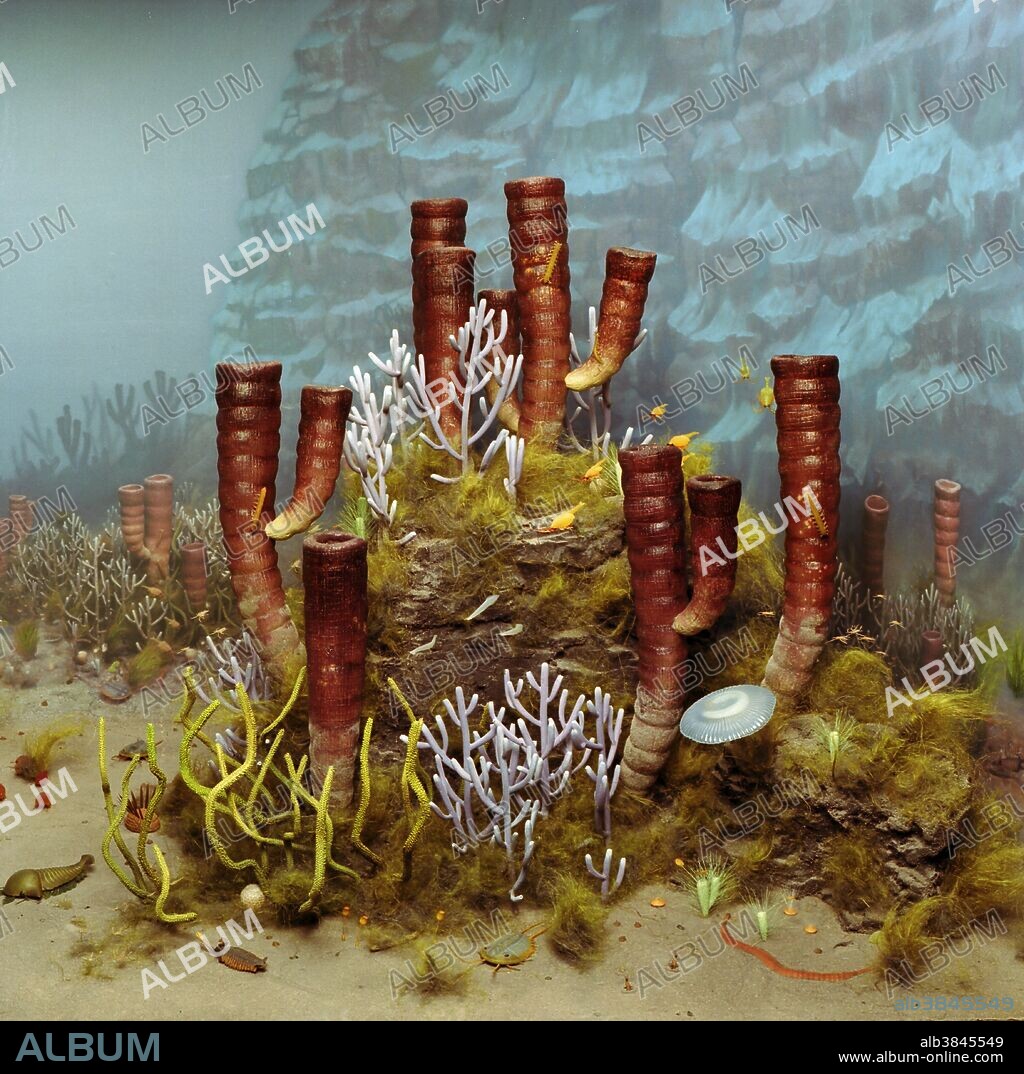alb3845549
Burgess Shale fauna

|
Add to another lightbox |
|
Add to another lightbox |



Title:
Burgess Shale fauna
Caption:
This reconstruction of the famous Middle Cambrian Burgess Shale fauna of British Columbia, is shown on a narrow shelf of an enormous submarine cliff, the "Cathedral Escarpment." Organisms fossilized in the Burgess Shale are thought to represent a community living in shallow water on the upper edge of the steep escarpment. Perhaps promoted by earthquakes or storm activity, chunks of this shallow, muddy substrate would slump off the precipice and plummet into deep water where the contained organisms were rapidly buried under a rain of sediment. The deep, oxygen-depleted water was free of predators, currents, and microbial activity which may have otherwise destroyed the entombed treasures. Known for its remarkable preservations of soft animal and plant tissues, the Burgess Shale provides us with a rare glimpse of earth's distant past. Prominent in the photo are large tube sponges (Vauxia densa), smaller branching tube sponges (Vauxia gracilenta), green knobby rod-like dasycladacean algae (Margaretia dorus), a jellyfish-like holothurian (Eldonia ludwigi), mats of filamentous algae (Marpolia spissa), and a variety of other smaller arthropods, echinoderms, worms, sponges, and animals of unknown affinity.
Credit:
Album / Science Source / Chase Studio
Releases:
Model: No - Property: No
Rights questions?
Rights questions?
Image size:
4708 x 4693 px | 63.2 MB
Print size:
39.9 x 39.7 cm | 15.7 x 15.6 in (300 dpi)
Keywords:
ALGA • ALGAE MATS • ALGAE • ALGAL MATS • ANIMAL FOSSIL • ANIMAL FOSSILS • ANIMAL • ANIMALS • ARTHROPOD • ARTHROPODA • ARTHROPODS • BRANCHING TUBE SPONGE • BRANCHING TUBE SPONGES • BRITISH COLUMBIA • BRITISH COLUMBIAN • BURGESS SHALE • BURGESS • CAMBRIAN PERIOD • CAMBRIAN • CANADA • CATHEDRAL ESCARPMENT • DASYCLADACEAN ALGA • DASYCLADACEAN ALGAE • DIORAMA • DIORAMAS • ECHINODERM • ECHINODERMATA • ECHINODERMS • ELDONIA LUDWIGI • ELDONIA • EXTINCT ANIMAL • EXTINCT ANIMALS • EXTINCT • EXTINCTION • FAUNA • FILAMENTOUS ALGA • FILAMENTOUS ALGAE • FOSSIL ANIMAL • FOSSIL ANIMALS • FOSSIL • FOSSILIZED • FOSSILS • HOLOTHURIAN • HOLOTHURIANS • ILLUSTRATED • ILLUSTRATION • ILLUSTRATIONS • MARGARETIA DORUS • MARGARETIA • MARINE LIFE • MARINE WORM • MARINE WORMS • MARPOLIA SPISSA • MARPOLIA • MIDDLE CAMBRIAN BURGESS SHALE • MIDDLE CAMBRIAN • MODEL • MODELS • PALEOZOIC ERA • PALEOZOIC • PREHISTORIC ANIMAL • PREHISTORIC ANIMALS • PREHISTORIC • PREHISTORY • RECONSTRUCTION • RECONSTRUCTIONS • SEA LIFE • SEASCAPE • SEASCAPES • SEAWEED • SPONGE • SPONGES • TUBE SPONGE • TUBE SPONGES • UNDERWATER LANDSCAPE • UNDERWATER LIFE • UNDERWATER SCENE • VAUXIA DENSA • VAUXIA GRACILENTA • VAUXIA • WILDLIFE • WORM • WORMS
 Pinterest
Pinterest Twitter
Twitter Facebook
Facebook Copy link
Copy link Email
Email

